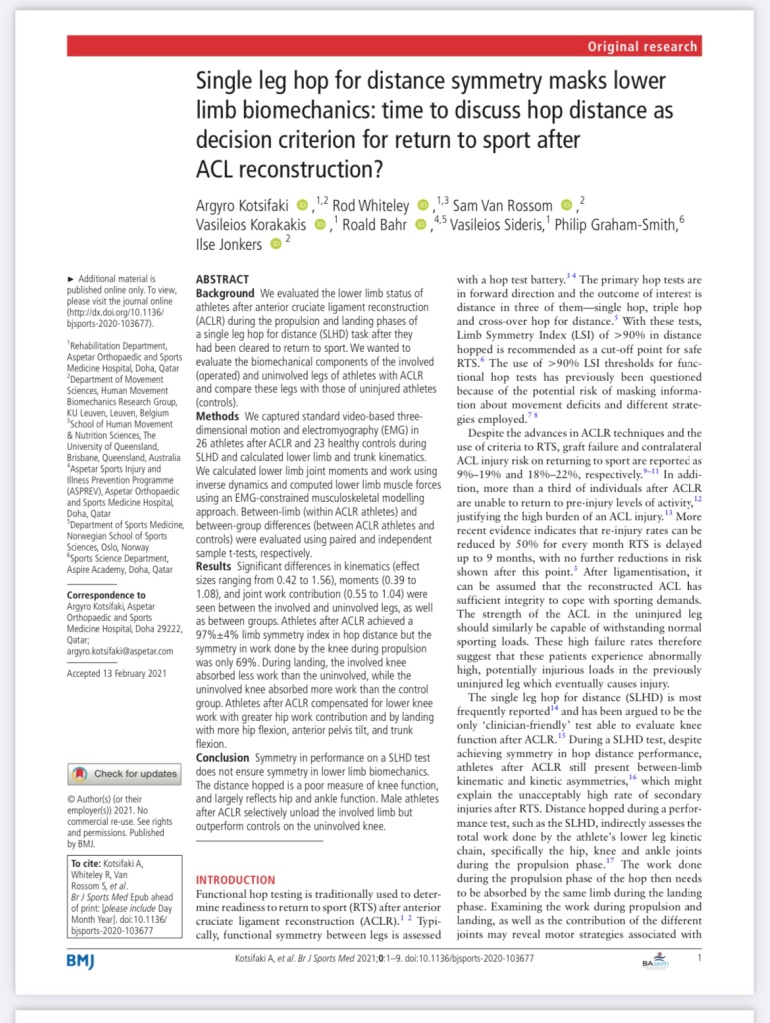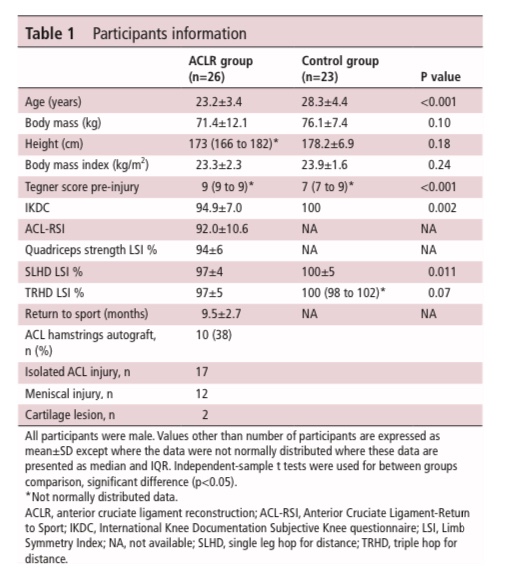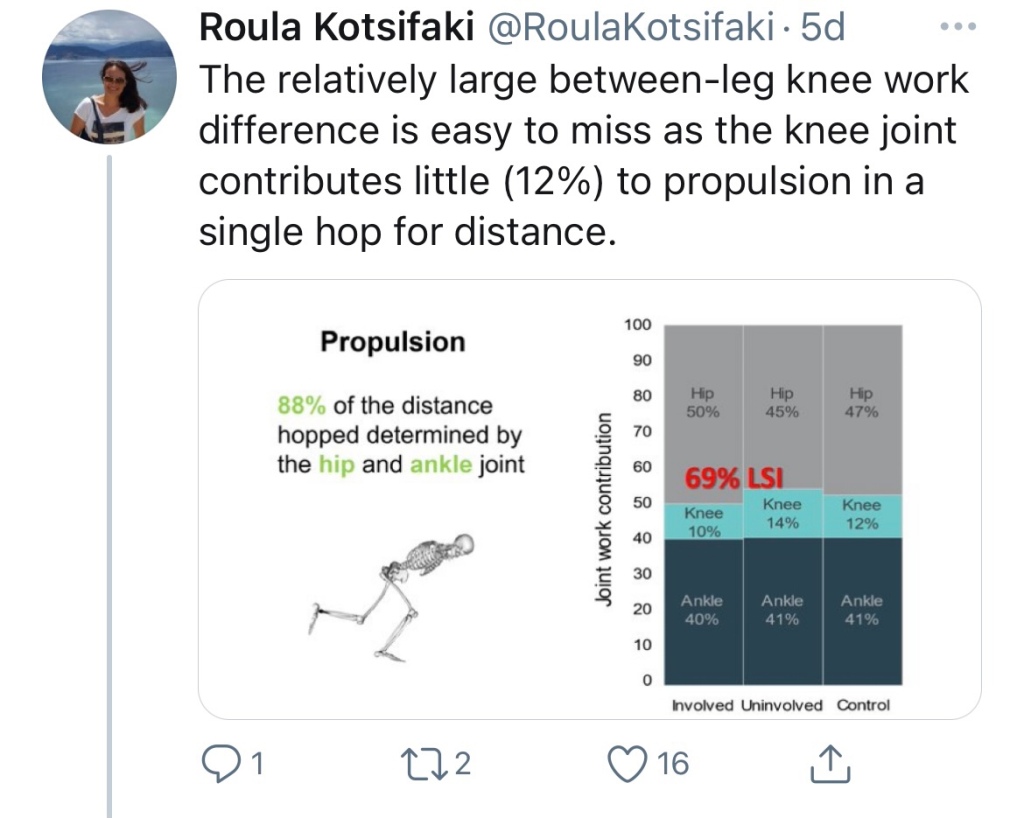To cite: Kotsifaki A, Whiteley R, Van
Rossom S, et al. Br J doi:10.1136/ bjsports-2020-103677
INTRODUCTION
Functional hop testing is traditionally used to determine readiness to return to sport (RTS) after anterior cruciate ligament reconstruction (ACLR).1 2 Typically, functional symmetry between legs is assessedwith a hop test battery The primary hop tests are in forward direction and the outcome of interest is distance in three of them—single hop, triple hop and cross-over hop for distance.5 With these tests, Limb Symmetry Index (LSI) of >90% in distance hopped is recommended as a cut-off point for safe RTS.
The work done during the propulsion phase of the hop then needs to be absorbed by the same limb during the landing phase. Examining the work during propulsion and landing, as well as the contribution of the different joints may reveal motor strategies associated with aberrantly high, potentially injurious, loads. The relative contributions of each part of the kinetic chain likely vary depending on the individual’s motor strategy. Protectively off-loading one joint might result in higher compensatory loading at another.
This article tried to describe depth the biomechanical performance (kinematics, kinetics, work, and individual muscle forces) of athletes at the time they had met all criteria for RTS and compare with healthy controls during the propulsion and landing phases of the SLHD. The objective of this study was to evaluate biomechanical components during the propulsion and landing phases of the SLHD test in athletes with ACLR who had passed criteria for RTS, compared with contralateral knees and uninjured athletes.
Participants, inclusion and exclusion criteria
49 male participants was included in this study, 26 eligible patients after primary ACLR and 23 control subjects The RTS process employs a shared decision making strategy18 which includes consideration of key RTS criteria including (1) clearance by both their surgeon and physiotherapist, (2) completion of a sports specific on-field Rehabilitation programme, (3) quadriceps strength LSI>90%, and (4) hop test battery LSI>90%0.4 ACLR individuals were athletes (preinjury Tegner score ≥7) aged between 18 and 35 years with a complete, unilateral ACL injury, either with an autologous ipsilateral bone-patellar-tendon-bone or a hamstrings graft (semitendinosus and gracilis) as clinically decided by the treating surgeon and athlete. Subjects with concomitant meniscal injury that did not significantly impede the rehabilitation course were also included in the study. Participants were excluded if they had concomitant grade III knee ligament injury (other than ACL), full thickness articular cartilage lesion, history of other lower extremity surgery (in either leg), back pain or lower extremity injury (other than primary ACL) in the prior 3 months.

DISCUSSION
Despite passing strict testing criteria to RTS, differences in biomechanics were identified between the injured and uninjured limbs of athletes after ACLR, as well as with the healthy comparison group.
Hop distance as a metric of knee function needs reappraisal
Athletes after ACLR were almost symmetrical in terms of hop distance (97%), but they still exhibited moderate to large differences in knee function. The ACLR group achieved 69% symmetry in knee work done during propulsion. This relatively large between-leg difference is more easily understood when we recognise that the knee joint contributes little (about 12%) to the propulsive phase of a SLHD. With 88% of the distance hopped being determined by the hip and ankle joint, deficits at the knee joint are easily missed. Simply put: the distance hopped is a poor measure of knee joint function, and largely reflects hip and ankle function. Consequently, it may not be the appropriate metric to use for testing an athlete with a knee injury and its relevance is questionable.




Clinical implications
Hop distance symmetry is commonly used as a criterion for an athlete to RTS after ACLR. The results of this study indicate that during a SLHD, symmetry in hop distance does not ensure symmetry in lower limb biomechanical parameters, especially for the knee joint. Future research might explore if these results can be generalised to the other common tests like the triple hop and the cross-over hop for distance and whether they measure similar constructs. Measuring hop distance, or its symmetry, risks overestimating rehabilitation status in terms of the knee joint, may lead to erroneous progression, and offers little additional clinical information in the RTS-readiness decision. Conversely, the SLHD task, and specifically the landing phase, can offer valuable information on the status of the knee joint, but requires three-dimensional biomechanical analysis—an apparatus not frequently available in clinical setting. Consequently, future research should focus on identifying proxy variables of these loading measures, perhaps from wearable technology or other approaches, which would allow monitoring these parameters in a clinical setting. In the absence of this technology, we suggest tasks other than SLHD, and variables other than hop distance may be more appropriate to capture the differences between legs and offer a more accurate estimation of the status of the knee.
CONCLUSION
Symmetry in performance of single leg hop distance masks important deficits in knee joint work in male athletes after ACLR. Specifically, they appear to underload their reconstructed knee during landing (while compensating at their hip) and overload their uninjured knee compared with healthy controls.











Most famous Tattoo studio in Croydon offers the most attractive tattoo design service in Croydon. Call today! we provide.The Future Within Never Say Die! Tattoo Croydon’s Biomechanical Tattoo Excellence.Tattoo Shops Croydon